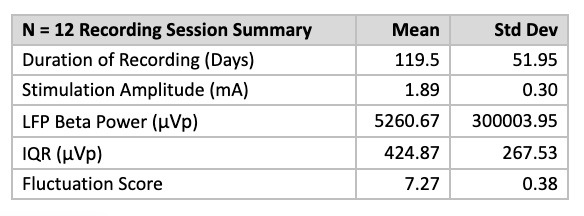Category: Parkinson's Disease: Neurophysiology
Objective: To determine if fluctuations in local field potential (LFP) beta power (BP) can be measured over time and whether the degree of fluctuation improves as therapeutic stimulation is optimized.
Background: LFP beta BP in Parkinson’s disease (PD) is considered a biomarker of symptom control, which can be modulated by both medication and stimulation. While acute changes in beta BP can assess effective stimulation, less is known about chronic BP dynamics during stimulation optimization. It is expected that stimulation titration will reduce BP and BP fluctuations over time.
Method: BP was assessed in consecutive patients implanted with Percept(R) devices for control of PD symptoms during the first 6 months of stimulation optimization. Inclusion criteria included constant sensing and stimulation “recording” settings (i.e., configuration, beta band of interest, pulse, frequency) with at least two months of data. Filtered and uniformly sampled raw BP data (9AM – 9PM) were retrieved in batches of days elapsed after first stimulation programming. Interquartile range (IQR) and fluctuation score (FS) (Log(∑5n=1IQRBP) [1] were calculated from daily BP values. Titrated stimulation amplitude was compared to each feature per group using Spearman rank correlation.
Results: N=12 segments (11 hemispheres) were recorded with mean duration=119.5 days (SD=51.95). [table1] Stimulation remained constant in N=1 segment and titrated an average of 1.82mA in the rest. BP, IQR and FS significantly correlated (p<0.05) with stimulation amplitude in n=10, n=8 and n=6 segments, respectively. In two segments positive correlation to stimulation was seen with all features, but little stimulation titration was present (range=.2mA). A negative correlation to stimulation titration occurred for BP in 7/11 segments (ρ=[-.47,-.052]), for FS in 9/11 segments (ρ=[-.8, -.15]), and for IQR in 9/11 segments (ρ=[-.68,- .08]).
Conclusion: BP fluctuations in response to stimulation are measurable. The expected negative correlation to stimulation titration was seen in most segments (82%) for FS and IQR. Although IQR showed the greatest number of significant correlations, FS shows stronger correlations with stimulation titration. Larger studies are needed to fully explore the relationship between magnitude of stimulation titration and effect on BP, effect of duration of stimulation, and relationship to symptom manifestations.
References: [1] Horne MK, McGregor S, Bergquist F (2015) An Objective Fluctuation Score for Parkinson’s Disease. PLOS ONE 10(4): e0124522. https://doi.org/10.1371/journal.pone.0124522.
To cite this abstract in AMA style:
S. Pitts, J. Jimenez-Shahed. Optimizing DBS in PD: Investigating LFP beta power fluctuations in response to chronic stimulation [abstract]. Mov Disord. 2023; 38 (suppl 1). https://www.mdsabstracts.org/abstract/optimizing-dbs-in-pd-investigating-lfp-beta-power-fluctuations-in-response-to-chronic-stimulation/. Accessed December 23, 2025.« Back to 2023 International Congress
MDS Abstracts - https://www.mdsabstracts.org/abstract/optimizing-dbs-in-pd-investigating-lfp-beta-power-fluctuations-in-response-to-chronic-stimulation/

